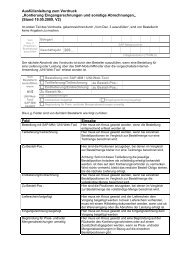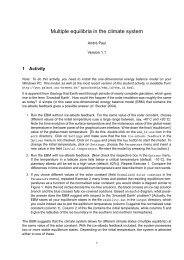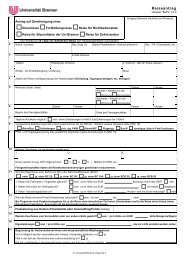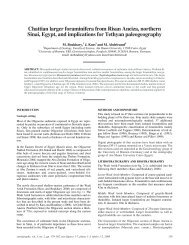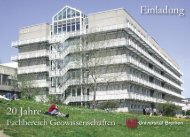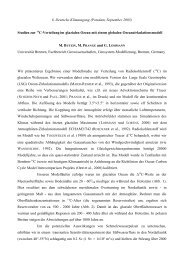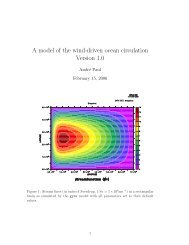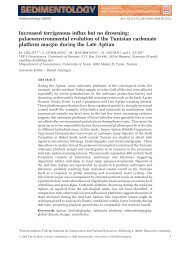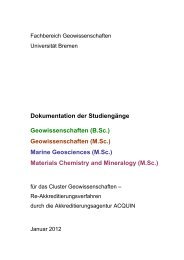Forschung im HLRN-Verbund 2011
Forschung im HLRN-Verbund 2011
Forschung im HLRN-Verbund 2011
- Keine Tags gefunden...
Erfolgreiche ePaper selbst erstellen
Machen Sie aus Ihren PDF Publikationen ein blätterbares Flipbook mit unserer einzigartigen Google optimierten e-Paper Software.
116Ecolonomically Improved Road VehiclesNumerical S<strong>im</strong>ulation of the Flow around a Generic Vehicle Using Active FlowControlS. Eichinger, F. Thiele, E. Wassen, Institutfür Strömungsmechanik und Technische Akustik,Technische Universität BerlinAbstract• The road transport of passengers and cargouses valuable fossil fuel and has a large contributionto greenhouse gas emissions.• Reducing the aerodynamic drag of vehicles isone possible way to decrease these negative effects.• In the case of ground vehicles the aerodynamicdrag is mainly pressure drag, which is caused byflow separation at the rear end of the vehicle.• With the help of active flow control devices (e.g.blowing slits) the flow around the vehicle can bechanged, so that the evolving pressure on thesurfaces results a lower aerodynamic drag.• Within this project the authors a<strong>im</strong> to developsuch a control strategy, using high-performancenumerical s<strong>im</strong>ulation of the flow.The aerodynamic drag of ground vehicles (e.g.trucks, busses or passenger cars) consists of twomain components: the friction drag and the pressuredrag. As the vehicle moves relative to the surroundingair, a friction force is generated betweenthe gas and the solid body surfaces due to the effectof viscosity. Because of the bluff shape of mostvehicles the flow is not able to follow the body contourat the rear end due to the effect of momentum.Here the flow separates, resulting in a pressure differencebetween the front and the rear parts whichmakes up the pressure drag. The separated regionsare dominated by complex three-d<strong>im</strong>ensionaland t<strong>im</strong>e-dependent vortices. The pressure distributionon the body surfaces are also dependent onthese structures. The drag force due to pressureis significantly larger than the friction force, and itstransient character can additionally cause stabilityand handling problems. The a<strong>im</strong> of the project is todevelop a method to influence the separated flowaround a generalized vehicle in such a way that thepressure drag is reduced. Consequently, the overallaerodynamic drag decreases, and the stabilityand the handling <strong>im</strong>proves as well.For the numerical flow s<strong>im</strong>ulation the Large-Eddy-S<strong>im</strong>ulation (LES) technique is used. The vehiclemodel is based on a form which is able to emulatethe main characteristics of a real vehicle, andit was introduced by Ahmed et.al. [1] and is calledAhmed body. The model has rounded edges at thefront part and a vertical rear end, s<strong>im</strong>ilar to vans,trucks or busses. For this configuration 85% of theaerodynamic drag is pressure-induced.With the help of active flow control the aerodynamicdrag can be reduced. The developedmethod uses steady blowing of air along the edgesof the rear-end surface through small slits. As afirst step, a baseline configuration without any actuationwas s<strong>im</strong>ulated. Thereafter, the direction andthe strength of the blowing was varied. A parameterstudy was performed, and a max<strong>im</strong>um dragreduction of 18% was achieved (for more detailssee: [2]). To ensure that the required energy inputto realize the blowing is not higher than theenergy gained due to the reduced drag, an efficiencycheck is necessary. It was found that thebest energy efficiency is achieved at a lower blowingspeed than the one that gives the highest dragreduction. The energy input decreases the benefitfrom the drag reduction, but still a net power gainof 10% was reached.In the next step instead of stationary blowingthe authors <strong>im</strong>plemented a robust closed-loop controllerinto the method. This controller algorithmcomputes an instantaneous value of the actuationvelocity, so that it is adjusted to the current flowconditions in order to reach a prescribed drag reductionvalue. The closed loop control method wasshown to work robustly even in the case of actuatorfailure, when, for instance, a drop of pressureoccurs in the actuator device during operation. Aninstantaneous flow situation on the road is neveridealistic. For example, in many cases there is atleast some cross-wind. It is <strong>im</strong>portant to check howthe active flow control method reacts in such conditions.Two setups of the above mentioned parameterstudy were s<strong>im</strong>ulated in cross-wind conditions.It was found that at θ = 45 ◦ and at a blowing speedequal to the inflow velocity the aerodynamic dragreduction was around 5%, while the net power gainwas 4%. With stronger actuation, for example 2.0t<strong>im</strong>es the inflow velocity, the drag reduction is 9%,but the net power gain drops to 1%.Since the wake of the vehicle is not symmetricin this case, more efficient flow control can beachieved with asymmetrically distributed blowing.This is done by using different blowing angles anddifferent blowing speeds at the different edges ofthe rear end. Currently the project deals with thisparameter study. Because of the relatively big pa-Ingenieurwissenschaften



